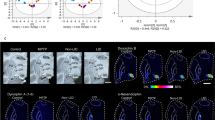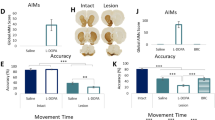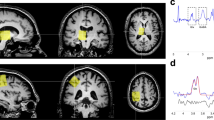Abstract
The movement disorder tardive dyskinesia is a serious side effect of the long-term treatment of schizophrenia with neuroleptic drugs. Similar symptoms to those of tardive dyskinesia have been observed in Cebus apella monkeys following long-term treatment with neuroleptic drugs1,2, and these monkeys may therefore be a useful animal model of tardive dyskinesia. Motor defects have persisted in these dyskinetic monkeys for periods of 1–6 yr after the cessation of neuroleptic treatment. We report here that in three regions of the brains of dyskinetic monkeys (substantia nigra, medial globus pallidus and subthalamic nucleus) glutamate decarboxylase activities and γ-aminobutyric acid (GABA) levels are reduced relative to control monkeys that had been treated with neuroleptics but which showed none of the symptoms of tardive dyskinesia. These results suggest that alterations in the GABA neurone system are involved in neuroleptic drug-induced tardive dyskinesia.
This is a preview of subscription content, access via your institution
Access options
Subscribe to this journal
Receive 51 print issues and online access
$199.00 per year
only $3.90 per issue
Buy this article
- Purchase on Springer Link
- Instant access to full article PDF
Prices may be subject to local taxes which are calculated during checkout
Similar content being viewed by others
References
Gunne, L.-M. & Bárány, S. Psychopharmacology 50, 237–240 (1976).
Bárány, S., Ingvast, A. & Gunne, L.-M. Res. Commun. chem. Path. Pharmac. 25, 269–279 (1979).
Bárány, S. A Primate Model for Acute Dystonia and Tardive Dyskinesia (Almqvist & Wiksell, Stockholm, 1983).
Gunne, L.-M. & Häggström, J.-E. Psychopharmacology 81, 191–194 (1983).
Häggström, J.-E., Sjöquist, B., Eckernäs, S.-Å, Ingvast, A. & Gunne, L.-M. Acta physiol. scand. suppl. (in the press).
Wiesel, F. A. & Sedvall, G. Brain Res. 65, 547–550 (1974).
Gale, K. & Casu, M. Molec. cell. Biochem. 39, 369–405 (1981).
Mao, C. & Costa, E. Psychopharmacology: A Generation of Progress (eds Lipton, M. A., DiMasicio, A. & Killam, K. F.) 307–318 (Raven, New York, 1978).
Redgrave, P., Dean, P., Souki, W. & Lewis, G. Psychopharmacology 75, 198–205 (1981).
Childs, J. A. & Gale, K. Life Sci. 33, 1007–1010 (1983).
Kilpatrick, I. C., Starr, M. S., James, T. A. & MacLeod, M. K. in GABA and the Basal Ganglia (eds DiChiara, G. & Gessa, G. L.) 205–224 (Raven, New York, 1981).
Reavill, C., Leigh, N., Jenner, P. & Marsden, C. D. Nature 287, 368 (1980).
Arnt, J. & Scheel-Krüger, J. Eur. J. Pharmac. 62, 51–61 (1980).
Coyle, J. T., Schwarcz, R., Bennet, J. P. & Campochiaro, P. Prog. Neuro-psychopharmac, 1, 13–20 (1977).
McGeer, P. L. & McGeer, E. G. J. Neurochem. 26, 65–76 (1976).
Lloyd, K. G. & Hornykiewicz, O. Nature 243, 522–523 (1973).
Brown, L. L. & Wolfson, L. I. Brain Res. 261, 213–229 (1983).
Ribak, C. E. in GABA and the Basal Ganglia (eds DiChiara, G. & Gessa, G. L.) 23–36 (Raven, New York, 1981).
Kim, J. S., Bak, I. J., Hassler, R. & Okada, Y. Expl Brain Res. 14, 95–104 (1971).
Hattori, T., McGeer, P. L., Fibiger, H. & McGeer, E. G. Brain Res. 54, 103–114 (1973).
Andén, N.-E. & Stock, G. Naunyn-Schmiedebergs Archs Pharmak. 279, 89–92 (1973).
Bartholini, G. & Stadler, H. in Chemical Tools in Catecholamine Research Vol 2 (eds Almgren, O., Carlsson, A. & Engel, J.) 235–241 (North-Holland, Amsterdam, 1975).
Hornykiewicz, O., Lloyd, K. G. & Davidson, L. in GABA in Nervous System Function (eds Roberts, E., Chase, T. N. & Tower, D. B.) 479–485 (Raven, New York, 1976).
Groves, P. M., Wilson, C. J., Young, S. J. & Rebec, G. V. Science 190, 522–529 (1975).
Scheel-Krüger, J., Arnt, J., Braestrup, C., Christensen, A. V. & Magelund, G. in GABA-Neurotransmitters (eds Krogsgaard-Larsen, P., Scheel-Krüger, J. & Kofod, H.) 447–464 (Munksgaard, Copenhagen and Academic, New York, 1978).
Grace, A. A. & Bunney, B. S. Eur. J. Pharmac. 59, 211–218 (1979).
Martin, G. E. & Haubrich, D. R. Nature 275, 230–231 (1978).
Waszcak, B. L., Eng, N. & Walters, J. R. Brain Res. 188, 185–197 (1980).
Klawans, H. L. Jr. Am. J. Psychiat. 130, 82–86 (1973).
Tarsy, D. & Baldessarini, R. J. Biol. Psychiat. 12, 431–450 (1977).
Asper, H. et al. Eur. J. Pharmac. 22, 287–294 (1973).
Author information
Authors and Affiliations
Rights and permissions
About this article
Cite this article
Gunne, LM., Häggström, JE. & Sjöquist, B. Association with persistent neuroleptic-induced dyskinesia of regional changes in brain GABA synthesis. Nature 309, 347–349 (1984). https://doi.org/10.1038/309347a0
Received:
Accepted:
Issue Date:
DOI: https://doi.org/10.1038/309347a0
This article is cited by
-
A novel giant non-cholinergic striatal interneuron restricted to the ventrolateral striatum coexpresses Kv3.3 potassium channel, parvalbumin, and the vesicular GABA transporter
Molecular Psychiatry (2022)
-
In silico screening of GABA aminotransferase inhibitors from the constituents of Valeriana officinalis by molecular docking and molecular dynamics simulation study
Journal of Molecular Modeling (2020)
-
Tardive Dyskinesia Associated with Atypical Antipsychotics: Prevalence, Mechanisms and Management Strategies
CNS Drugs (2018)
-
Resveratrol Protects Against Vacuous Chewing Movements Induced by Chronic Treatment with Fluphenazine
Neurochemical Research (2017)
-
Aripiprazole differentially regulates the expression of Gad67 and γ-aminobutyric acid transporters in rat brain
European Archives of Psychiatry and Clinical Neuroscience (2013)
Comments
By submitting a comment you agree to abide by our Terms and Community Guidelines. If you find something abusive or that does not comply with our terms or guidelines please flag it as inappropriate.



